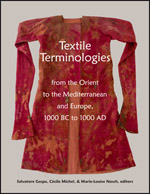Centre for Textile Research
Date of this Version
2017
Document Type
Article
Citation
In Textile Terminologies from the Orient to the Mediterranean and Europe, 1000 BC to 1000 AD, ed. Salvatore Gaspa, Cécile Michel, & Marie-Louise Nosch (Lincoln, NE: Zea Books, 2017), pp. 483-491.
doi:10.13014/K2MW2F9S
Abstract
This paper aims to investigate the origin of the term gammadia by determining the oldest examples of its use both in source texts and secondary literature.1 For nearly four centuries this term was commonly applied to the various motifs on mantles of figures represented in art of the 1st millennium AD.2 These right-angled and letter-like signs attracted the attention of several authors who were seeking to explain their possible symbolic meaning, but they did not pay attention to the correctness of the term adapted to name such motifs.3 This approach contributed to the terminological confusion and difficulties in understanding the issue at hand.
Dictionaries and travel guides: The semantic scope of the term gammadia was defined by the editors and authors of Latin dictionaries and travel guides in the 17th century. The definition of this term most likely appeared for the first time in 1663 in the lexicon Vocabulista ecclesiastico, a book which became very popular and was reprinted many times. According to this laconic and anonymous text, the term referred to a garment or chasuble which had woven signs in the shape of the Greek letter gamma. At roughly the same time, Benedetto Mellini gave a people who recognized gammadiae as signs composed of four gammas forming a cross ╬. A very similar definition and illustration were also included in the Hierolexicon sive sacrum dictionarium which was published in 1677. In all three texts the authors referred to Anastasius the Librarian as the origin of the term, more specifically to the Book of Pontiffs, Liber Pontificalis, whose authorship was once attributed to him.
The Book of Pontiffs: The Liber Pontificalis (here abbreviated LP) is probably the only textual source in which the term gammadia appears.10 The term can most often be found in acc. pl. fem. as gammadias, rarely in abl. pl. fem. as gammadiis11 or in acc. pl. fem. without gemination as gamadias.12 It is present in the sections covering the lives of six popes over a narrow period of only 63 years. It is mentioned for the first time in the description of the gifts of Pope Leo III (795-816)13, and for the last time in the biography of Pope Benedict III (855-858).14 In the text the term gammadia is mostly applied in conjunction with the names of various types of utilitarian textiles called vestis, velum and tetravila. It also appears in relation to the names of architectural elements such as columns and arches.
Included in
Ancient History, Greek and Roman through Late Antiquity Commons, Art and Materials Conservation Commons, Classical Archaeology and Art History Commons, Classical Literature and Philology Commons, Fiber, Textile, and Weaving Arts Commons, Indo-European Linguistics and Philology Commons, Jewish Studies Commons, Museum Studies Commons, Near Eastern Languages and Societies Commons, Other History of Art, Architecture, and Archaeology Commons


Comments
Copyright © 2017 Salvatore Gaspa, Cécile Michel, & Marie-Louise Nosch. Photographs copyright as noted.